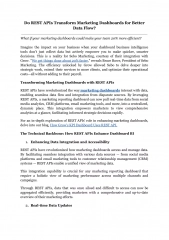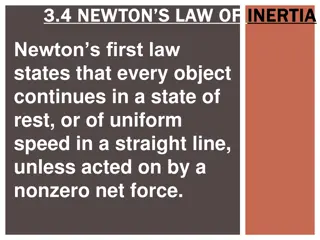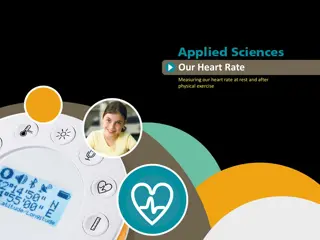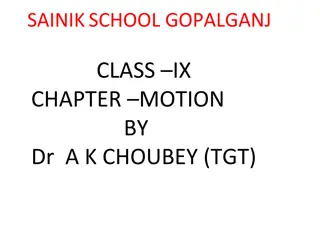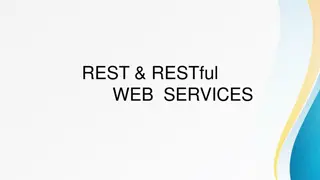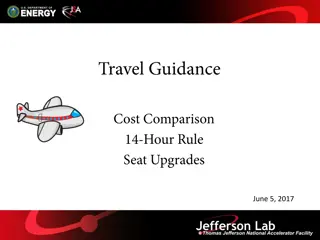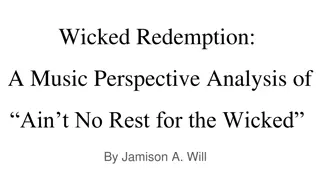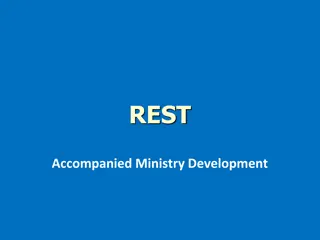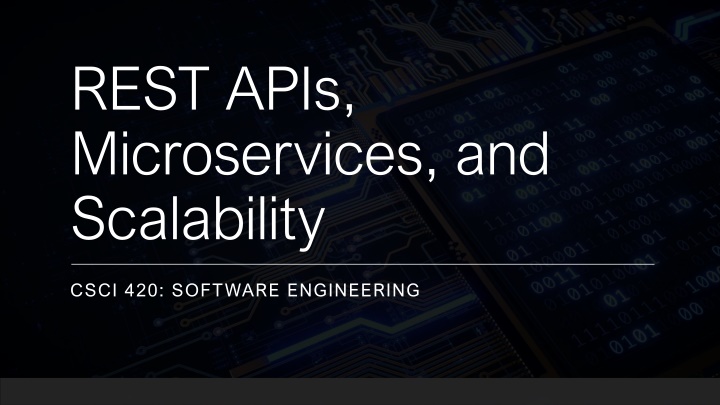
REST APIs, Microservices, and Scalability in Software Engineering
This content delves into the fundamental concepts of REST APIs and microservices, emphasizing the principles of Representational State Transfer (REST). It discusses the key abstractions of information as resources, interaction context, representation metadata, idempotent operations, and the presence of intermediaries in REST architecture. Additionally, it covers the significance of resources, URIs, and the importance of descriptive and human-parseable URIs in web development.
Download Presentation

Please find below an Image/Link to download the presentation.
The content on the website is provided AS IS for your information and personal use only. It may not be sold, licensed, or shared on other websites without obtaining consent from the author. If you encounter any issues during the download, it is possible that the publisher has removed the file from their server.
You are allowed to download the files provided on this website for personal or commercial use, subject to the condition that they are used lawfully. All files are the property of their respective owners.
The content on the website is provided AS IS for your information and personal use only. It may not be sold, licensed, or shared on other websites without obtaining consent from the author.
E N D
Presentation Transcript
REST APIs, Microservices, and Scalability CSCI 420: SOFTWARE ENGINEERING
REST RE REpresentational S State T Transfer Architectural style of the web Used by websites (AJAX) Set of design criteria NOT the physical structure (or architecture) of the system NOT tied to the web or HTTP Web applications are the most prevalent Collaboration Productivity (MS Office, Google Docs, Github) Social Networks
REST Principles 1. The key abstraction of information is a resource Any information that can be named can be a resource resource which is named by a URI URI. 2. All interactions All interactions are context Each interaction contains all the information necessary to understand the request Independent Independent of any request that may have preceded it context- -free free 3. A resource resource is just a sequence of bytes, plus representation metadata Specific form of representation can be negotiated between REST components metadata to describe those bytes
REST Principles 4. Components Components perform only a small set of well Either produce a representation (state) or transfer representation between components (transfer) Methods are global to the specific REST architectural instantiation All exposed resources are expected to support each operation identically well- -defined methods defined methods 5. Idempotent operations Idempotent operations and representation metadata (Woah, some 10-cent words there discussed on future slides) Supports caching and representation reuse representation metadata are encouraged 6. The presence of intermediaries Filtering or redirection is okay Useful when you need to augment, restrict, or modify requests/responses in a manner that is transparent intermediaries is promoted
REST Resources Anything that s important enough to be referenced as a thing in itself Something that can be stored on a computer and represented as a stream of bits A document A row in a database Output(s) of executing an algorithm JSON/YAML/XML
REST URIs A URI URI is an address of a resource resource A resource must have at least one URI URI Resource No URI means not a resource URIs should be descriptive and human-parseable http://cs.millersville.edu/~wkillian/2019/fall/csci420 https://autolab.millersville.edu/courses/420-f19/assessments https://autolab.millersville.edu/courses/362-f19/assessments/array/submissions/9001/view Bad URIs Everything as a query parameter http://www.ex.com?software software=Prism&release release=latest&filetype filetype=tar&method method=fetch
REST Addressability An application application is addressable if it exposes interesting aspects interesting aspects of its data set as resources resources An addressable application exposes a URI for every piece of information it might serve Enables a user to bookmark URIs or embed them e.g. on a powerpoint slide: http://www.google.com/q?csci+420+millersville Rather than a prescribed list of steps
REST Statelessness Every request request happens in complete isolation Server shall NEVER rely on information from prior requests There is no specific ordering of client requests complete isolation Possible states Possible states of a server can be represented as resources resources and given their own URIs URIs
REST Representations Resources != Data Abstraction of how information is split for presentation/consumption Server must respond to a request by sending a payload In a specific file format XML JSON HTML PDF In a specified language English Spanish
REST Representation Request Style 1: Distinct URI for each ex.com/media/2019-11.en ex.com/media/2019-11.fr Style 2: Content Negotiation Expose Platonic form URI: ex.com/media/2019-11 Client sets request headers: Accept: Accept-Language:
REST Uniform Interface HTTP Provides 4 basic methods for CRUD (CRUD: Create, Read, Update, Delete) GET retrieve representation of resource PUT update/modify existing resource (or create a new resource) POST create a new resource DELETE delete an existing resource Two additional (less commonly used) methods HEAD fetch metadata of representation only OPTIONS check which HTTP methods a resource supports
HTTP Request/Response Method Request Entity-Body/Representation Response Entity-Body/Representation GET (Usually) Empty Representation/entity-body sent by client Server returns representation of resource in HTTP Response DELETE (Usually) Empty Representation/entity-body sent by client Server may return entity body with status message or nothing at all PUT (Usually) Client s proposed representation of resource in entity-body Server may respond back with status message or with copy of representation or nothing at all POST Client s proposed representation of resource in entity-body Server may respond back with status message or with copy of representation or nothing at all
PUT vs POST POST Commonly used for creating subordinate resources existing in relation to some parent Parent: /logs/mylog (table in DB) Children: /logs/mylog/entries/1 (row in table) PUT Usually used for modifying existing resources May be used for creating resources PUT vs. POST (for creation) PUT: client in charge of deciding which URI resource POST: server in charge of deciding which URI resource
PUT vs POST (continued) In the case of partial updates PUT: send completely new representation overwriting current POST: create new resource In Practice PUT for partial works fine No evidence/claim for why it can t (or shouldn t) POST may also be used and some purists prefer this Ultimately, your manager/supervisor will determine requirements for you
REST Safety and Idempotence Depends on calls being correctly used correctly used Safety Safety The request doesn t change the server state No side effects Making 10 requests is the same as making one (or even none!) Idempotence Idempotence Executing the same operation is the same as executing once Deleting an already DELETE-ed resource is still deleted Updating an already UPDATE-ed resource with PUT has no effect
Idempotence When performing an operation again gives the same result HTTP Method HTTP Method GET HEAD PUT DELETE POST PATCH Idempotence Idempotence YES YES YES YES YES YES YES YES NO NO NO NO Safety Safety YES YES YES YES NO NO NO NO NO NO NO NO
RESTful Architecture: Steps to Success 1. Figure out the dataset 2. Split dataset into resources, then for each kind of resource: 1. Name resources with URIs 2. Expose a subset of uniform interface 3. Design representation(s) accepted from client 4. Design representation(s) served to client 5. Consider typical course of events (sunny-day scenarios) 6. Consider alternative/error conditions (rainy-day scenarios) for each kind of resource:
HTTP Status/Response Codes HTTP has built-in set of status codes 2XX Success (200 OK, 201 Created, etc) 3XX Redirection (303 See other) 4XX Client error (404 not found) 5XX Server error (500 Internal Server Error) Leverage existing status codes to handle Sunny day scenarios Rainy day scenarios Do not try to reinvent the wheel!
RESTful Notes Authentication/Authorization data sent with every request Sessions are NOT RESTful (sessions state) Cookies (if used appropriately) are RESTful 100% RESTful should not necessarily be a goal Login/Logout Some server frameworks only support GET/POST Forces developer to overload POST for PUT/DELETE
Benefits of RESTful Design Simpler and Intuitive Design Server doesn t have to worry about client timeout Clients can easily service interruptions / server restart Easily distributed Scalable Stateless easier to cache Bookmarkable
3-Tier Architecture Design Layer 1: Presentation HTML CSS JS Layer 2: Business Logic RESTful framework MVC Layer 3: Data Access ORM tools: Hibernate, Spring JDBC, ActiveRecord (Ruby, DataMapper) May already be integrated with RESTful framework and represented as Models in MVC
Significance 100% REST isn t a goal but REST should still be a target Various architectures can be composable MVC on client-side? Event-based communication is necessary for real-time and asynchronous applications
Microservices microservice architectural style an approach to developing a single application as a suite of small services each running in its own process and communicating with lightweight mechanisms often an HTTP resource API
Service Oriented Architectures (SOA) APIs APIs SOA/ESB SOA/ESB API Management Here is what I have to offer Backend App is the Product The API is the contract And the product This is what I need WSDL is the Contract
Monolithic Applications
Scaling Monolithic Applications
Monolithic Application w/ Increased Features
Microservices Accessing Shared DB
Microservices Characteristics Many smaller (fine grained), clearly scoped services Single Responsibility Principle Independently Managed Clear ownership for each service Typically need/adopt the DevOps model
REST Example: Autolab https://autolab.github.io/docs/api-interface/ Tango https://autolab.github.io/docs/tango-rest/

